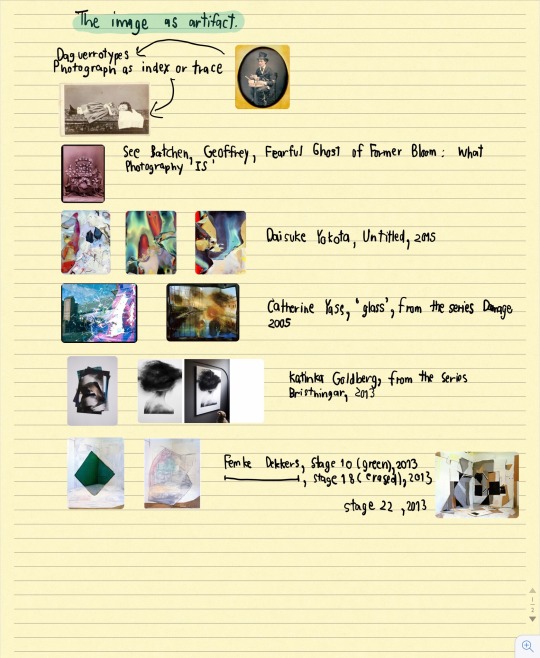#5IMAG016W
Explore tagged Tumblr posts
Text
First meeting of presentation group:
I thought I was well prepared, but I had missed the real learning behind which was to collaborate with other students! I did not feel confident in the ideas that I was bringing to the meeting, as I found the theoretical concepts interesting but I felt I only just understood them myself, as soon as somebody asked me to explain the concepts even when I tried, I could see that I had not made myself understood, and in no way had I sparked a glimmer of interest :) I had worked quite hard to get the information together, but on reflection I would have been better off trying to make contact with the other students in the group. As our lecturer pointed out, how can we cover the subject of philosophy as method with four individuals each doing five minuites. In the meeting I found myself far more interested in her ideas about Arthur Schopenhauen and Joseph Campbell then my own ideas. I suppose this is what makes collaboration interesting.
We decided to divide the presentation up into: Schopenhauer; Joseph Campbell; Artists/Pictures; Paul Graham.
We had a not of discussion about the order...we started with Schopenhauer, but a group member felt that it was very important to start with context first. I need to read up on Schopenhauer, Campbell and Graham and am hoping I will have a better understanding of why it is important to start with context.
My five minuites is about looking at artists/pictures using philosophy as research....Schopenhauer, Campbell, Graham
3 notes
·
View notes
Text
Beyond The Frame - Projection
I have finally managed to use a projector thanks to the store technicians who explained to me how to use it. What I was trying to do was to show whatever was on my iPhone Screen to the wall through a projector, but there are a few things that I still have to work out:
I need a Google Chromecast or Apple TV media streamer compatible with IOS devices. Simply attaching a MediaPlayer at the back of a projector doesn't work as it only supports Android
I have to find a way to glue the Phone to a stand and then glue the stand to the plinth so that it doesn't get stolen. Therefore I will have to buy a cheap iPhone.
I have to keep the phone constantly connected to the power so probably make a hole in the plinth and get a long phone charger cable.
I have to make the video! And play it on loop.
Upload as many images as possible in the next 2 weeks.
I have to find a way for the screen to remain on Instagram ( don't log out, don't access other apps, don't change - just remain on Instagram )
Make sure I will have a projector on the day we are putting the work up (ask Ulrike about it) & fix the technical issues (ask Connor) & work on the concept ( ask Gavin)
In the meantime here is an example of how today went:
2 notes
·
View notes
Text
‘ARM’ Psychoanalysis Presentation - 20/11/19 w/ Neil Matheson
Today we presented our discussion on psychoanalysis as a methodology of approaching photography. Tanya spoke of Freudian theory of the dream and the individual unconscious and how it is accessed through dreams and certain projects that have, intentionally or not, reflected the reflected these ideas, mainly in the era of surrealism.
She mentioned how Man Ray had firstly engaged in the idea of masculine driven ideas of the world and that much of surrealist mentality lay in that of the dream world. She spoke of how surrealism was often concerned with sexual, phallic and sexually representational forms in their work. Particularly in May Ray’s work she noted that he found substance in the eroticism of the female form and the literal landscape of the body and how this could be presented in certain images.
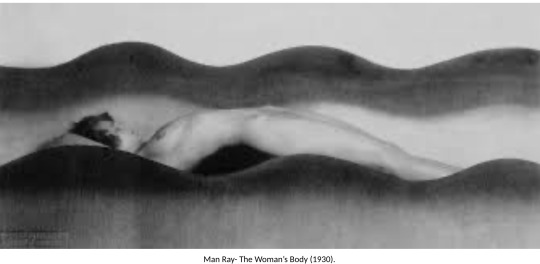
This is a particular example that Tanya presented as part of Man Ray’s ideas.
She then moved on to the work of Hans Bellmer and his series of dolls, which I found to be particularly relevant in what psychoanalysis can do in looking at images. She touched upon Bellmer’s tough upbringing and his confusing and violent relationship with his father, and possible none existent relationship to his mother. The project, as Tanya mentioned, came out because of these previous life traumas and led to him creating a project that contained objects, or subjects, in doll like form, of which he had full control over.
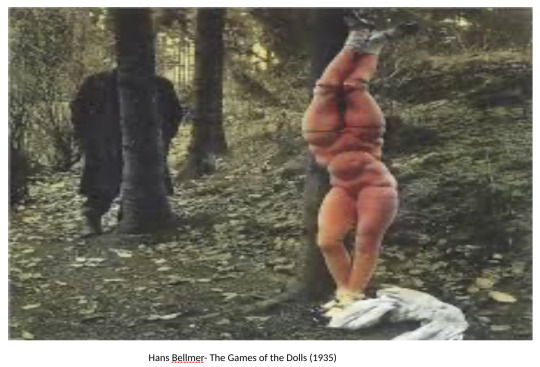
This example displays a predatory, control driven set of values (something Bellmer lacked as a child) and was able to bring to light art that allowed his inner angst and traumatised conscious and subconscious mind to deal with.
Elsa then moved on to talking on Jung’s theories of ‘personal consciousness’ and ‘collective consciousness’, namely using August Sander to highlight what ‘collective unconsciousness’ is and the way it can be handled in photographic terms.
She spoke of how a typology of societal classes (in Germany pre WWII) gave collective information to the masses and therefore great collective consciousness to the people of a society, in an attempt to understand what kind of society they lived in.
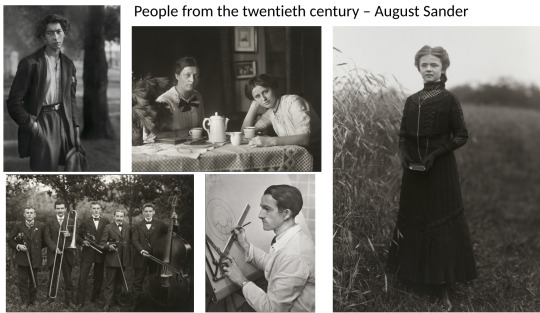
This kind of understanding is what allows a society to see itself for what it really is. Subsequently, it was banned by Hitler (therefore backing up exactly the kind of power that images can have) with the idea that it may give rise to an analysis of the way things were and therefore a criticism of it.
I then spoke about, in more general terms, how psychoanalysis can not only inform our approach to looking and analysing other people’s images but also how it can affect our perspective towards our own practice, and help to bring out ideas for projects by looking within our own understanding of ourselves.

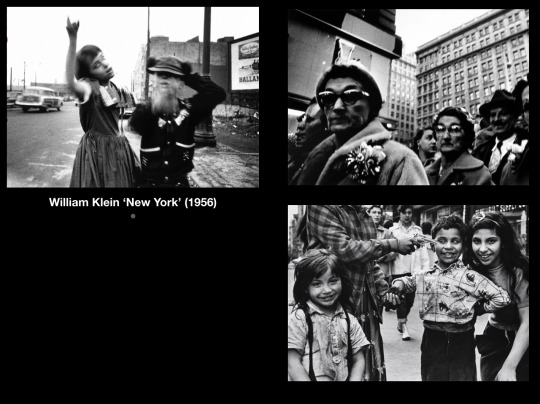
Firstly I looked at Bill Klein’s book ‘New York’ to prove a point as to how ideas raised from psychoanalysis enter our practice whether we intend them to or not. The entire book is somewhat of a retaliation towards NYC for all the damage and brutality that it offered him as a child. To this day, Klein still speaks about NYC as being a “shithole” of craziness. Everything from the often loose framing, to the blurred figures, right up to the perspective and framing was fashioned by his childhood experience.
I then moved on to the Jungian idea of the ‘pleasure’ and ‘reality’ principles. These are the set of ideas that dictate our societal and cultural behaviours. The ‘pleasure principle’ is the idea that we would do anything, at any time, in any place on the basis of what feels good to us. We obviously do not do this, and what stops us from doing so is the ‘reality principle’, which, as Jung describes, is born out of cultural, societal and ancestral understanding of the world and the process in which it functions. But what happens when someone reacts against this way of thinking?
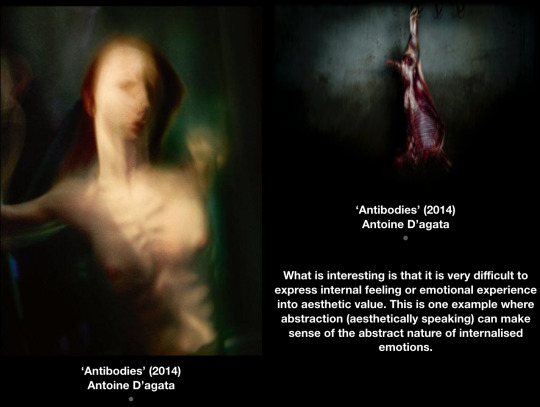
D’agata’s work is a perfect example of how, not only his relation to pleasure and the experience of someone else’s shifted (probably through a reaction against his childhood) but also publishing (into the image viewing community) his own dissatisfaction with the ‘reality principle’. Everything about D’agata’s book reveals taboo, and mostly unspoken sections of society, and yet he creates and possibly experiences the pleasure and joy of such taboo subjectivity in his ability to photograph it all. What is endlessly fascinating about this work, and really most photographic work, is how it reveals as much about the photographer as it does the subject of their image making.
1 note
·
View note
Text
History as a field and Method of photographic research:
(week 5)
“all photographs are produced within a context. A photographer works with materials within a definite social place and time. These materials and choices the photographer exercise of them, whether conscious or not, organises the look of the picture”. (Bate, D, 2009, p.16) - This was my favourite piece of text/ quote that was spoken about in todays lecture. I like thought/ focus on the fact that all images have some sort of context behind them no matter what the subject and/or the reasoning is.
What is historical research?
= Historical research enables you to explore and explain the meanings, phases and characteristics of a phenomenon or process at a particular point of time in the past.
Historical research has the potential to completely change the mood of an image depending on what the image is of and what historical events were going on in the world at the time of the photo being taken, which could possibly effect the meaning and the purpose of said image.
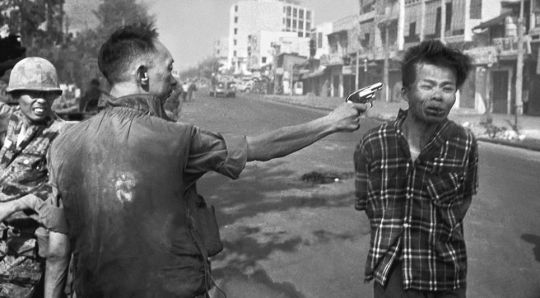
This famous image by Eddie Adams taken (1st February 1968) during the Vietnam War. The image shows the execution of a Viet Cong prisoner seconds before the gun is fired thus killing the man.
Now of course without any historical research the image still affects the viewer purely just by how horrific the situation within the photo actually is, since you are clearly able to see what is going to happen. However by revealing the information of the historical events behind the photo, it can now effect people in different ways. Depending on where you may live in the world and what their own situation and opinions are about the war itself.
1 note
·
View note
Text
Feast for the Eyes - Exhibition - Advanced Research Methods
30th October 2019 - The Photographers’ Gallery
The second exhibition on when visitied the photographers’ Gallery, was Feast for the Eyes - The Story of Food Photography which broadly explored the history of food photography. There were a wide variety of work from different photographers such as Stephen Shore, Guy Bourdin, Hank Willis Thomas or even Russell Lee.
Again, I think any kind of methodology could be used while analysing this work. It might depends from images on their own than when looking at the whole body of work. But after rereading what I wrote about the exhibition, I think I unconsciously used a photographic theory kind of approach.
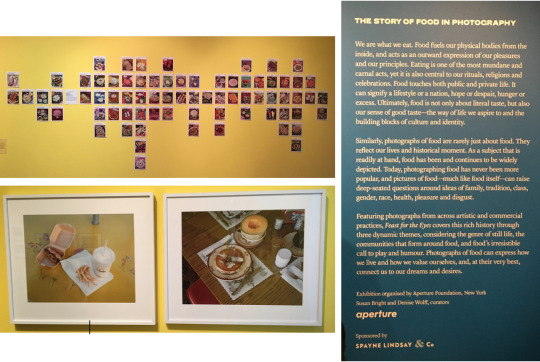
For example, the two images from Stephen Shore above could be analysed by looking at the history of still life. Why did he photograph them this way, what does it mean. We’ve learned in the past that whether it was painting or photography, the use of “rare” aliments was a way to show how wealthy people were. For example in one of the photo further below dated from the 1850′s from photographer Roger Fenton, we can find a pineapple which was quite a rare fruit to get at the time, it highlights a certain wealth that we can’t really see on, for example, Shore’s image above of a fast food meal.

Roger Fenton, Decanter and Fruit, ca. 1853-60 (left) Wolfgang Tillmans, Summer Still Life, (right)
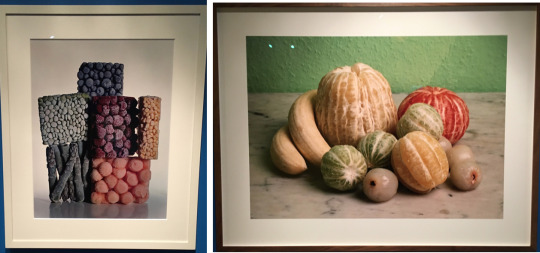
Irving Penn, Frozen Foods, 1977 (left) Holger Niehaus, Untitled, 2000 (right)
The two images above reminded me of something that Walter Benjamin wrote in his article about the book of Karl Blossfeldt on plant photography (Artforms in Nature) and how Blossfeldt’s images were a new way to perceive the world. In a way we rarely look at fruits and vegetable this way. Penn and Niehaus, both, showed us a different way to look at those elements, a way that we have never really looked at before.
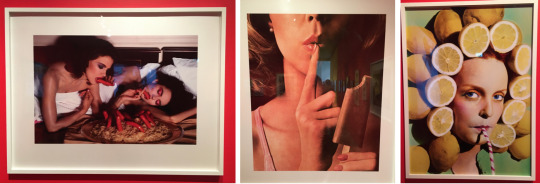
Guy Bourdin, Vogue Paris, September 1981 Hank Willis Thomas, You’ll Never Guess Our Deep, Dark, Delicious Secret, 1984/2015
We could also find a lot of fashion and commercial images in the exhibition which was to me very unexpected but not out of theme. It was actually fascinating how disturbing some of them were such as the one from Guy Bourdin (above, left) of the two models eating sausages.
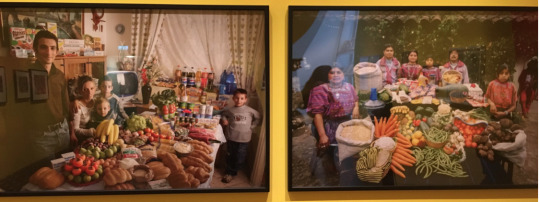
We could also find some more documentary directed kind of work such as the two images above from photographer Peter Menzel who photographed what families eat for a certain amount of time. It highlights how different our alimentation is depending on our culture and wealth.
Another quite interesting documentary images showed, was the images from Russell Lee expressing a rather harsh reality after the War.
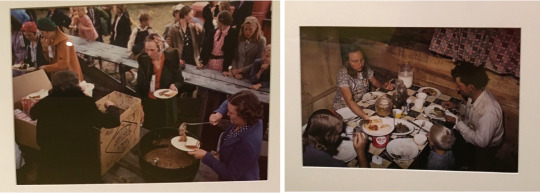
1 note
·
View note
Text
Advanced research methods. Lecture 1
The introduction to this module was extremely helpful in understanding the key concepts of the module, the tasks this module involves and the potential routes I may take when writing my essay. What I found most interesting is the detail you can get into when analysing with multiple methodologies. For example you may start out with a broad scope such as political theory, and then delve in deeper using a more precise theory. Alongside theoretical methodology is historical analysis, as explained to us can be used as a separate method or in unison with theoretical methods.
When thinking about an essay for this module I would like to use my prior knowledge in Historical theories and social theories to analyse a piece of work. One idea is to analyse historical issues or social issues using methodologies that stem from history theory. A photographer that I would like to do some research into is Don Mcullen and his work in Vietnam. As a piece of history it is very interesting how the wars coverage changed the worlds view on the fighting. However further research is needed on this topic.
I aim to use many forms of media to research this topic as the key will be to analyse don Mcullen’s work with a historical context. To do this I will have to understand the time period his work in Vietnam was made, by researching the time. My main aim will be to research the American culture at the time; however this war affected many other countries, so this will be taken into account. Apart from history methodology, I will look into using social, political and architectural theories as they all play a part in his work while helping me to analyse the time period.
1 note
·
View note
Text
Shape of Light Exhibition, Tate Modern
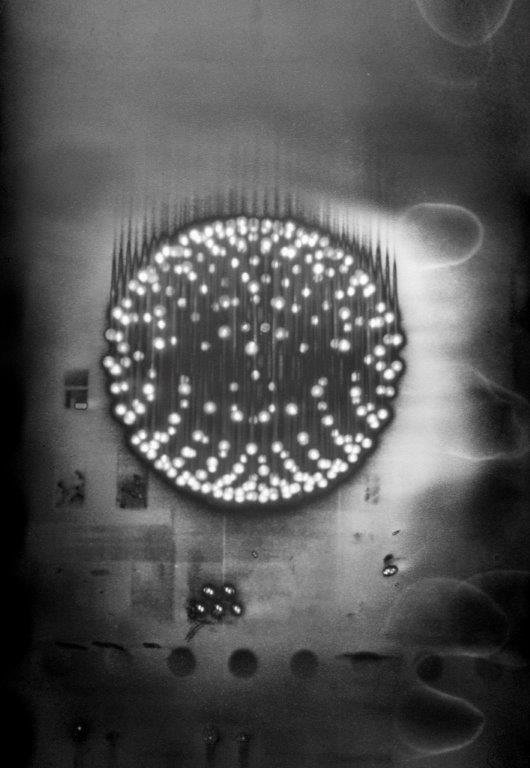
This was one of the most inspiring exhibitions I had been to in quite a while, this exhibition has really opened my eyes to new ways of executing photographic methods. I had recently been questioning what photography is to me and how it can be considered a skill or how photographers can be considered as talented as a painter perhaps, but this exhibition with all these beautiful and unique abstract forms of photography has really inspired me to try quite literally everything I’ve seen here, I came for inspiration for one project and left with several.
An artist who really stuck our for me was Peter Keetman, who had a series entitled, ‘Light Pendulum Oscillation’, an intricate and somehow almost mechanic dance of light exposed into a crisp photograph. A significant part of this series is the contrast with the more concentrated pieces of light creating some incredibly bright eye-catching areas and some equally beautiful faded and spaced out, creating mysterious almost murmuration-esque patterns.

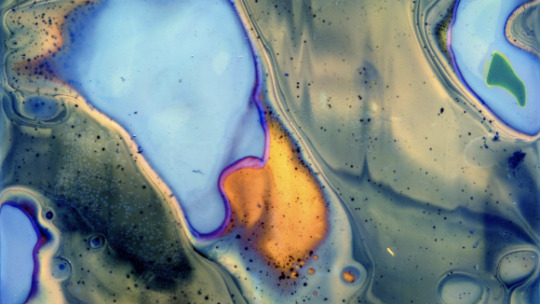
Another incredibly beautiful form of abstract photography that I found was the use of chemigraphs, these create incredibly abstract and beautifully coloured and ironically fluid flowing images. The creation of chemigraphs brought together two different artistic forms of painting and photography, the chemigraphs presented within the exhibition are used without a camera (so I suppose does this still class as photography or is it painting with chemicals or just another medium altogether?) they are created through using photographic chemicals on light sensitive photopaper. The outcomes are entirely unique although different effects can be achieved by changing the light that hits the paper or many artists have used materials such as wax, polish or varnish to block chemical reactions, creating the most beautiful and unexpected abstract ‘photographs’.
2 notes
·
View notes
Text

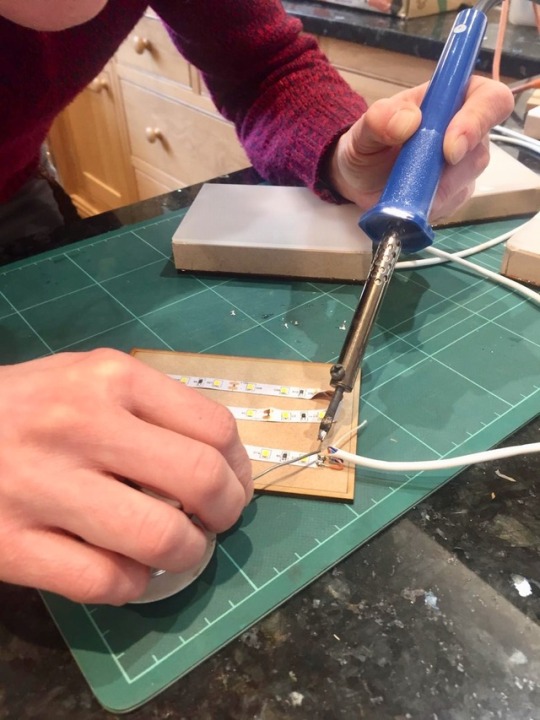
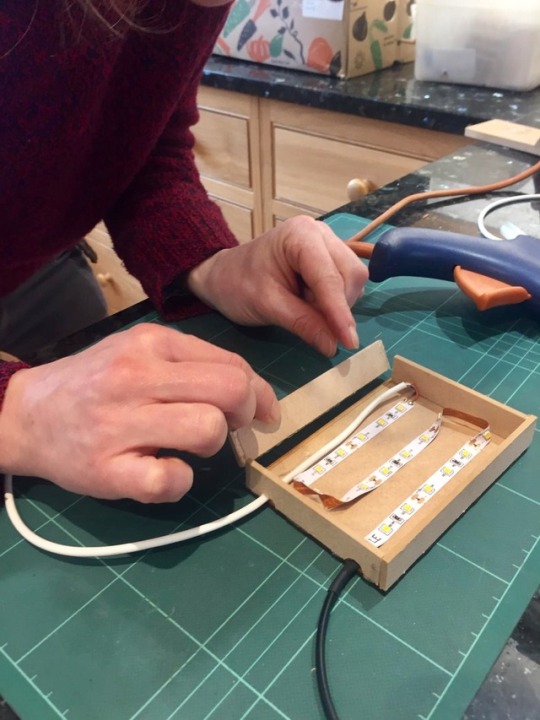
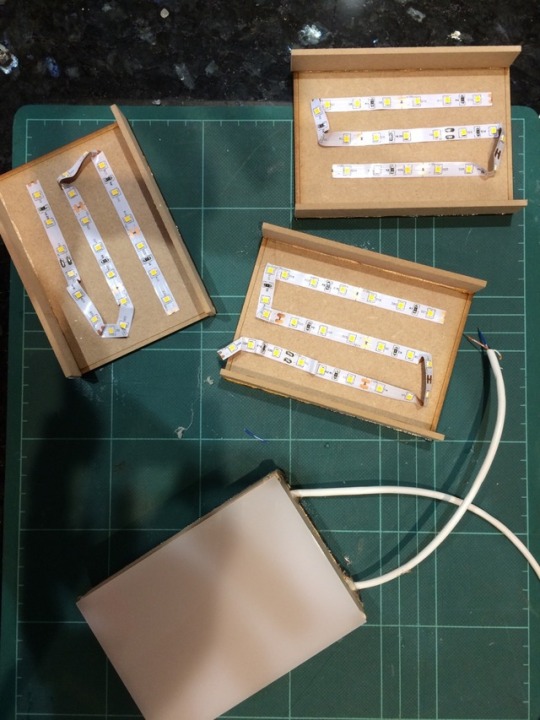
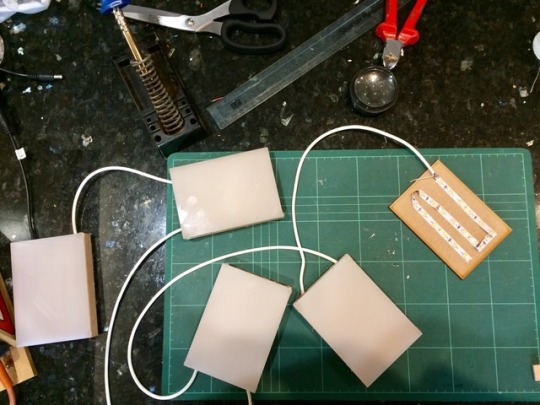
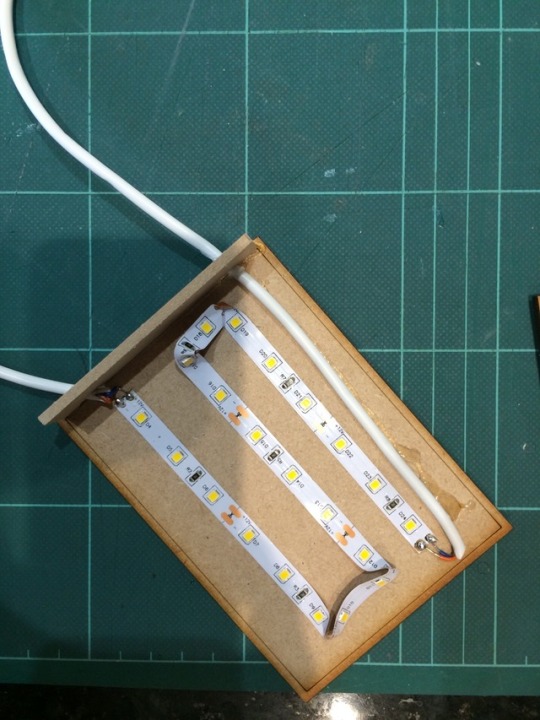
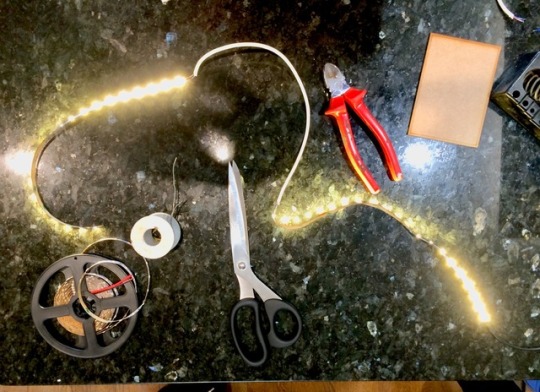
Working on DIY light boxes for my Miss P. Jones project. On the meeting with Connor from Media Emergency Space we designed in adobe illustrator light boxes templates for laser cut. Materials used for construction were mdf, opal acrylic and LED lights. After cutting all elements my friend gave the lesson about basic electricity rules and I was able to connect all boxes with wires and the light boxes came to the life!!!
1 note
·
View note
Text
Double exposures with Phase One
I had booked studio 6 and the phase one camera for Friday 23rd and had arranged for my model to come in to uni. Unfortunately she was ill and could not make it. So I decided to experiment in the studio anyway and try out producing double exposures with the phase one. I got PJ to model for me. We shot on a very slow exposure of 15s and linked the camera to two different flashes. We turned all lights off to shoot in complete darkness, and we used the flash to act as a shutter. The studio basically acted as a camera body and the flash units as the shutter release.
So I pressed the shutter and using the phase one’s countdown, I fired the flash on the 5th, the 10th and the 14th seconds. Between each flash fire, PJ changed positions to create the double exposure effect.
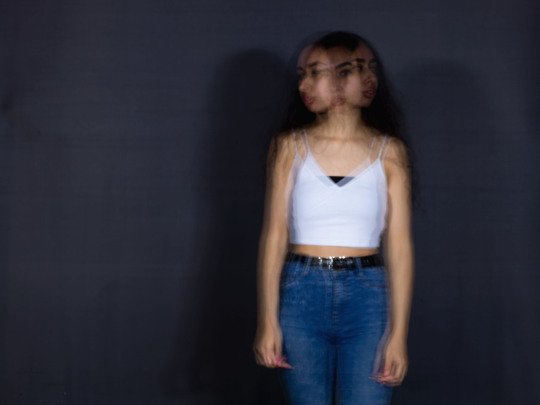
We also tried exposing several times using an additional light source with a phone torch.
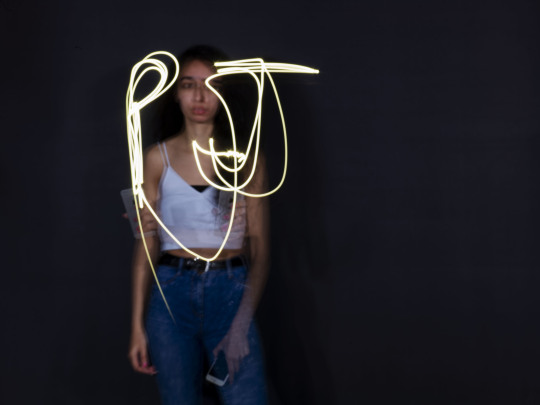
1 note
·
View note
Text
Seiichi Furuya
Seiichi Furuya: ‘Graz’, 1979
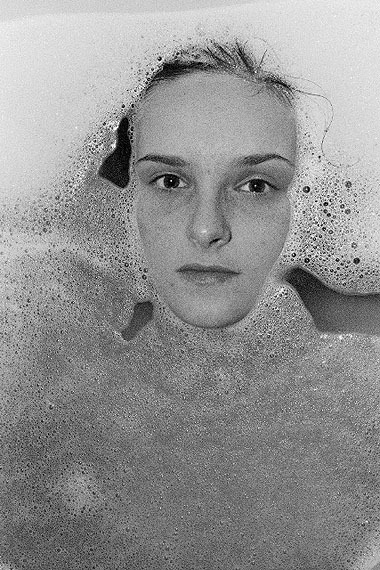
In a simple, yet striking portrait, Seiichi Furuya pays tribute to the phrase, “there is always more to someone than meets the eye.” Through both visual metaphor and compositional structure, the photo titled Graz muses on the idea that a person’s beauty may conceal what they are feeling or thinking. Humans are, after all, a sum of paradoxes, who have flaws contained within beauty, and who do not always share on their face what may be lingering beneath the surface.
I first saw this portrait at SFMOMA and was immediately drawn to it. We see a woman’s face staring directly into the camera, her body obscured by bath water. Her expression is calm and yet her slightly raised eyebrow suggests something is being hidden. Perhaps, a joke is being shared between her and the photographer?
Whether intentional or not, the water becomes a blurred surface, shades of grey and white that allow the viewer to focus solely on the intricacies of this woman’s expression. Indeed, the subject’s close proximity to the lens, the implied bathroom setting, and her direct eye contact make us wonder what could have created the context for such an image. It is an incredibly intimate portrait.
Further research[1][2] reveals that Graz is a photograph of the artist’s wife. Christine Gössler met Furuya in 1978. She lived in Austria with her husband, and in 1985, she committed suicide. This portrait was taken only a few years before her death and the knowledge of that event casts a melancholy shadow over the beauty of the image. Looking again at the portrait, is there a veil of sadness over her eyes? Is she emerging or retreating? What is lingering beneath the surface of that gaze?
The photo becomes that much more rich as Furuya sets up the visual metaphor of a face emerging from the surface of water, while the rest of the body is obscured. Initially, we bear witness to an intimate moment between husband and wife, but ultimately we are seeing a woman whose story would soon change dramatically.
Much of Furuya’s work revolves around his wife. There is a curiosity, care, and respect for her that permeates his practice. In a descriptive piece on the photographer, the Metropolitan Museum writes, “Like a writer mulling over his material, Furuya coaxes clues out of the unanswerable questions of human suffering and experience.”
Naturally, Furuya uses his talent and skill as a photographer to make sense of his marriage and his wife’s condition. In his oeuvre, he pays tribute to Christine’s life and her beauty. In the end, his portrait, and all portraiture, is a tool for understanding humanity. Our flaws, our beauty, and our individuality all contained within a figure or expression frozen in time.
While not incredibly well known, Seiichi Furuya’s work is a worthy addition to the canon of photographic portraits taken in the 20th century.
2 notes
·
View notes
Text
Beyond The Frame - Metal Stands (Done) & Advanced and Research Method’s Seminar (Done)
Today, after doing our seminar presentation (which by the way went very well) I have finally managed to finish the metal stands that I had previously created in the 3D workshop. These stands are going to hold the ceramic dolls ( which represent people) during the exhibition for the “Beyond The Frame” module. I bought a Hammered Black Metal Spray Paint from Amazon that I have used in the Spray Booth ( behind the 3D workshop).
This is the result so far:
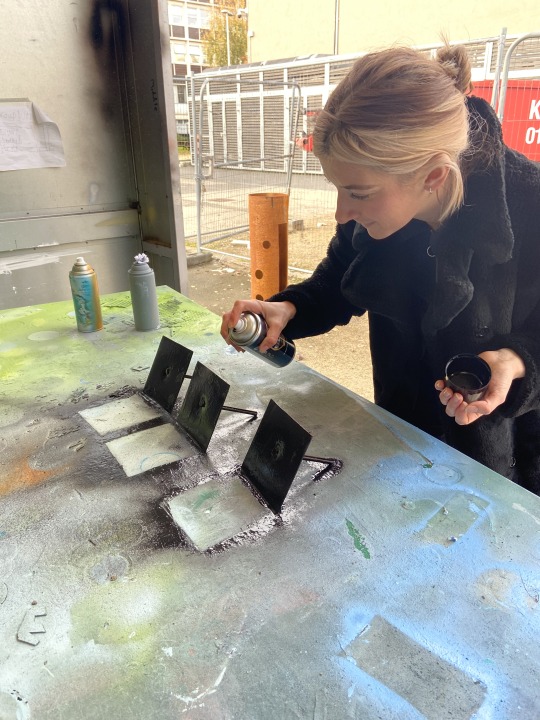

(Photos were taken by Me&another student Roberta Viale)
The result is looking good so far although I might have to do at least 3-4 coats for maximum protection ( as stated on the can’s instruction) :)
Tomorrow I have organised a quick personal tutorial with Gavin to use the projector and see how the video will look like when projected into a wall. As I have never used one before, I need someone to show it to me. Also, I have no idea how to create a video ( apart from the screen-recording that I have done through my phone), therefore I have signed up for a Workshop with the Video Technologies Specialist ( Georgie Matzko) on the 2nd&9th of December to learn at least the basics of Premiere Pro software.
I am very excited to be learning the use of so many different mediums and techniques during this module, however, I am realising how “limited” we can be as photographers is we stick only to one medium (like digital or analog cameras) while we could be adopting many more devices as we are living in such a technological era. Or I wonder.. Is this the whole point of this module???
2 notes
·
View notes
Text
Advanced Research Methods entry 1
At first I found myself a little bit confused with the point of the lecture and the significance and purpose of methodologies themselves. That feeling quickly disappeared once we got into the practical/discussion aspect of the class though. Breaking own a multitude of images by method proved to be an effective method of demonstrating just why methods are important both in academic writing and as a part of a wholesome understanding of a piece of art. My group was "tasked" with discussing a fashion image off an unknown to me artist's photobook.(Edit: The photographer is Viviane Sassen; the image has been inserted for context and clarity.)
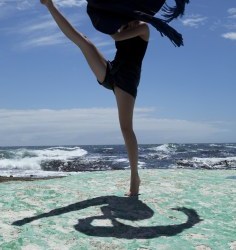
We started off slow but quickly picked up the pace, figuring out more and more ways to analyse the image from all sorts of different angles. We started looking at it purely photographically at first, breaking it down via artistic and photographic theory, referencing significant form, semiotics, the color palette, etc. We then dug a little deeper and started going through the different methodologies listed as examples in the powerpoint, just to see what we can get to fit and what we can't. Someone suggested exploring the image using gender theory, which I personally disagreed with as I didn't consider the sex of the subject to be of any significance to the content of the photograph we looked at.
As for why methodologies are important and I'd argue even somewhat necessary to academic writing, I find they provide a couple of very important things - they contextualise and validate our statements by directly referencing pre-established and renowned theories, effectively allowing us to make use and stand on the shoulders of very signifiant and often expansive research, without having to bother with referencing all of its intricacies (i.e. when breaking down an image using formalist analysis I don't need to go back and explain or prove why significant form is important to certain photographs). Another huge benefit at least for me is that methodologies are a great starting point for analysis - certain theories fit certain images better than others and when we constrain ourselves to using just one or two to dig into a piece of work I find it concentrates our efforts, allowing for a deeper and therefore more valuable understanding of a piece of work. Another benefit is providing a different and novel point of view, for instance, let’s take this image by Rachel Whiteread:
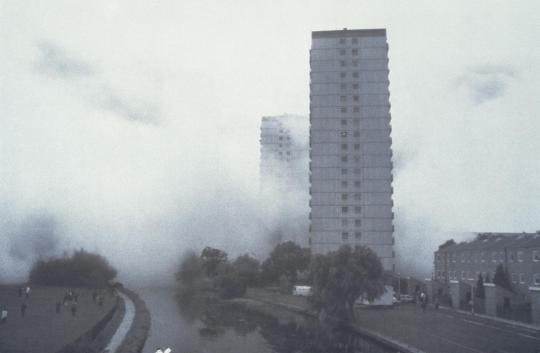
It could very well be an architecture shot or a street photograph, in which case we could employ methods better suited to its analysis as such. While that would undoubtably result in some deeper understanding of the image, it would also mean we completely miss the point of the project as a piece of documentary work, representing certain sociopolitical movements of the time as well as alluding to the artist’s own background and environment. The reason why I chose to reference this project in particular is actually a friend of mine that’s not particularly invested in art that I went to the Tate Modern with some time ago - she looked at these images and seemed really unimpressed, until reading the supporting statement on the wall - to me that’s a really practical demonstration of why methods are important - while they don’t offer a complete or rounded understanding of a piece of art, they do work well to point us in the right direction and make sure we as consumers are speaking the same language as the artist.
1 note
·
View note
Text
Presentation groups
25.11.20
After a few online meetings my group ‘history’ have decided to work our presentation around Avant Garde Russian revolution photography. This is an area that I have not looked at before so it will be interesting g for me to work with my group to discover what I can find. We decided to take a part of the presentation each, my part is an exhibition’ Masters of Soviet Photographic Art’ The exhibition took place in 1935 and was well accepted as an important exhibition of its time.
I have enjoyed listening to other presentations and it nice to see how everyone has interpreted their subject.
0 notes
Text
Art History and Theory as Method
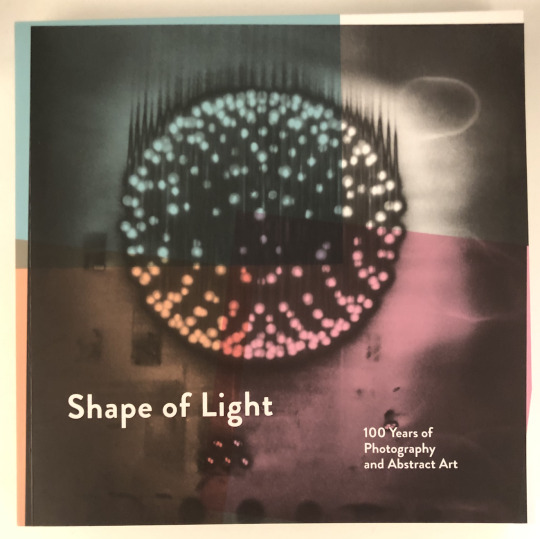
(week 4)
For todays lecture I had chosen to bring in my copy of the the Shape of Light catalogue, which I bought during our visit to the exhibition back in the first year of the course. - A catalogue is a list of the works included in an exhibition.
Discuss how you might use areas of the history and/or theory of art in analysing some appropriate images.
It is clear that art history and photography have a very close connection between one another.This is due to the fact that once photography really came into existence the two mediums would take inspiration from each other.
A great example of this would be looking at the artist, Juan Sanchez Cotan (born 1561) who had painted the well known piece, “Quince, Cabbage, Melon and Cucumber”. The painting shows these products within what looks to be a small cove in a wall acting as a shelf. Both the quince and the cabbage are being suspended in the air by two pieces of string, leaving the melon and the cucumber laying on the shelf. I think this is a perfect example for what I stated in my opening since many years later this image was actually recreated by an American photographer named Paulette Tavormina in 2010.
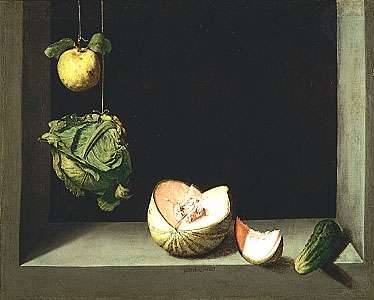

Even though that in my opinion Tavormina’s version is a lot less dramatic since I think it holds a lot less detail compared to the actual painting, but it still holds a certain charm to its slightly more minimalist style as it almost allows you to split the images into different sections, causing you to shift your focus from one object to another rather than giving you that wider scale of a painting which can sometimes force you to be stuck in the mind frame of it being one singular piece that is to be examined as a whole.
1 note
·
View note
Text
yourself - critical evaluation
NAME: “yourself”
Throughout the project, it has gone through numerous phases of how exactly it would turn out to be, at first, I was nearly intent with Wildlife or Landscape photography; this project was to change course and explore an avenue that in itself is one that I am not the most confident in. I found myself focusing on portraits, and this project explores the idea of being “yourself”.
The project “yourself”, explores the personality or character of the person in front of the lens, and the way in which they can radiate their personality through what they actually do without instructions given by the photographer. Of course a single image cannot possibly hope to indicate all of the models’ personality, yet it adventures (to an extent) into the notion of personality. Attempting to reiterate to some extent the ways in which some express themselves through their actions, be it; dancing, standing, singing etc. The reason this project requires an open mind is because the images themselves suggest and hint at the personality of the person, it does not give the answer entirely to the audience, it dances around the idea of personality through image.
I found this project to be quite reinvigorating and it allowed me to further develop my photography and my relationship with the people who modelled for me, I found this to be a change in terms of exploring new avenues of photography and stepping out of my comfort zone. I discovered that portrait photography is a great method that can help one to be more open minded; furthermore it can aid one to come out of an antisocial mind set and become more sociable. Achieved through the aid of music, friends and open-mindedness.
Our lectures that often included portraiture as a subject, really did help during my initial proposal for the project, it furthermore lead me to discover Shea Glover a photographer in the states who captured what she perceived as beautiful. She achieves this by asking some strangers or friends to model for her; she then proceeded to converse with her subjects and she told them they were beautiful, to which they reacted in an honest and astonished manner. This got me thinking about my project, whether I wanted to capture the typical portraits in which the model is told what to do; however I soon discovered through tutorials and a visit to Thomas Ruff at the Whitechapel that I would prefer to honestly capture my friends in a manner that poses no particular perspective.
The project “yourself” particularly focuses on the idea of audience perception, as the photographs themselves hint and dance around my friends’ personality; they rely on the way in which the audience reacts to the image. I find that allowing the model more control over the shoot additionally provides a deeper perspective regarding personality, they chose the background, pose and clothing, and I myself merely photographed what they did. Overall the project was quite successful from a personal perspective.
2 notes
·
View notes
